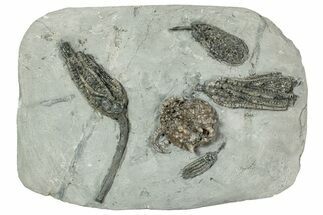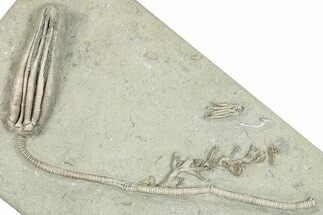This Specimen has been sold.
18.8" Fossil Crinoid Plate (Nine Species) - Crawfordsville, Indiana
These are nine separate species of crinoids (14 total) that come from "The Bluffs" near Crawfordsville, Indiana. The crinoids include an Abrotocrinus coreyi crinoid (#1), an Abrotocrinus unicus crinoid (#2), three Histocrinus coreyi crinoids (#28), a Pachylocrinus aequalis crinoid (#35), a Decadocrinus depressus crinoid (#42), an unidentified crinoid (#45), two Gilbertsocrinus tuberosus crinoids (#68), three Platycrinites hemisphericus crinoids (#73) and a Onychocrinus exculptus crinoid (#83). The quality of preparation on these fossils is exquisite - using skillful air-abrasion techniques under a stereo microscope.
The longest stems on this plate have all been repaired or mounted, though some are natural. It is accompanied by a metal display stand.
#1 - Abrotocrinus coreyi (2.9" long)
#2 - Abrotocrinus unicus (.9" long including stem)
#28 - Histocrinus coreyi (1.35", 1.4", and 2.55" long)
#35 - Pachylocrinus aequalis (1.8" long)
#42 - Decadocrinus depressus (1.7" long)
#45 - Unidentified (.8" long)
#68 - Gilbertsocrinus tuberosus (2.8" & 3.2" wide)
#73 - Platycrinites hemisphericus (1.7", 2.1", and 3.8" long including stems)
#83 - Onychocrinus exculptus (5.4" long including stem)
The longest stems on this plate have all been repaired or mounted, though some are natural. It is accompanied by a metal display stand.
#1 - Abrotocrinus coreyi (2.9" long)
#2 - Abrotocrinus unicus (.9" long including stem)
#28 - Histocrinus coreyi (1.35", 1.4", and 2.55" long)
#35 - Pachylocrinus aequalis (1.8" long)
#42 - Decadocrinus depressus (1.7" long)
#45 - Unidentified (.8" long)
#68 - Gilbertsocrinus tuberosus (2.8" & 3.2" wide)
#73 - Platycrinites hemisphericus (1.7", 2.1", and 3.8" long including stems)
#83 - Onychocrinus exculptus (5.4" long including stem)
Crinoids from the Ramp Creek Limestone were likely buried in sediment from nearby deltas during storms. The resulting siltstone deposits are soft enough that fossils can be extracted in exquisite, three-dimensional relief.
Crinoids, sometimes commonly referred to as sea lilies, are animals, not plants. They are echinoderms related to starfish, sea urchins, and brittle stars. Many crinoid traits are like other members of their phylum. Such traits include tube feet, radial symmetry, a water vascular system, and appendages in multiples of five (pentameral). They first appeared in the Ordovician (488 million years ago) and some species are still alive today.
Crinoids, sometimes commonly referred to as sea lilies, are animals, not plants. They are echinoderms related to starfish, sea urchins, and brittle stars. Many crinoid traits are like other members of their phylum. Such traits include tube feet, radial symmetry, a water vascular system, and appendages in multiples of five (pentameral). They first appeared in the Ordovician (488 million years ago) and some species are still alive today.
SPECIES
A. coreyi, A. unicus, H. coreyi, P. aequalis, D. depressus, G. tuberosus, P. hemisphericus & O. exculptus
LOCATION
Bluff's Site, Crawfordsville, Indiana
FORMATION
Edwardsville Formation
SIZE
18.8 x 10.6" rock
CATEGORY
SUB CATEGORY
ITEM
#231996
We guarantee the authenticity of all of our specimens.
 Reviews
Reviews





















